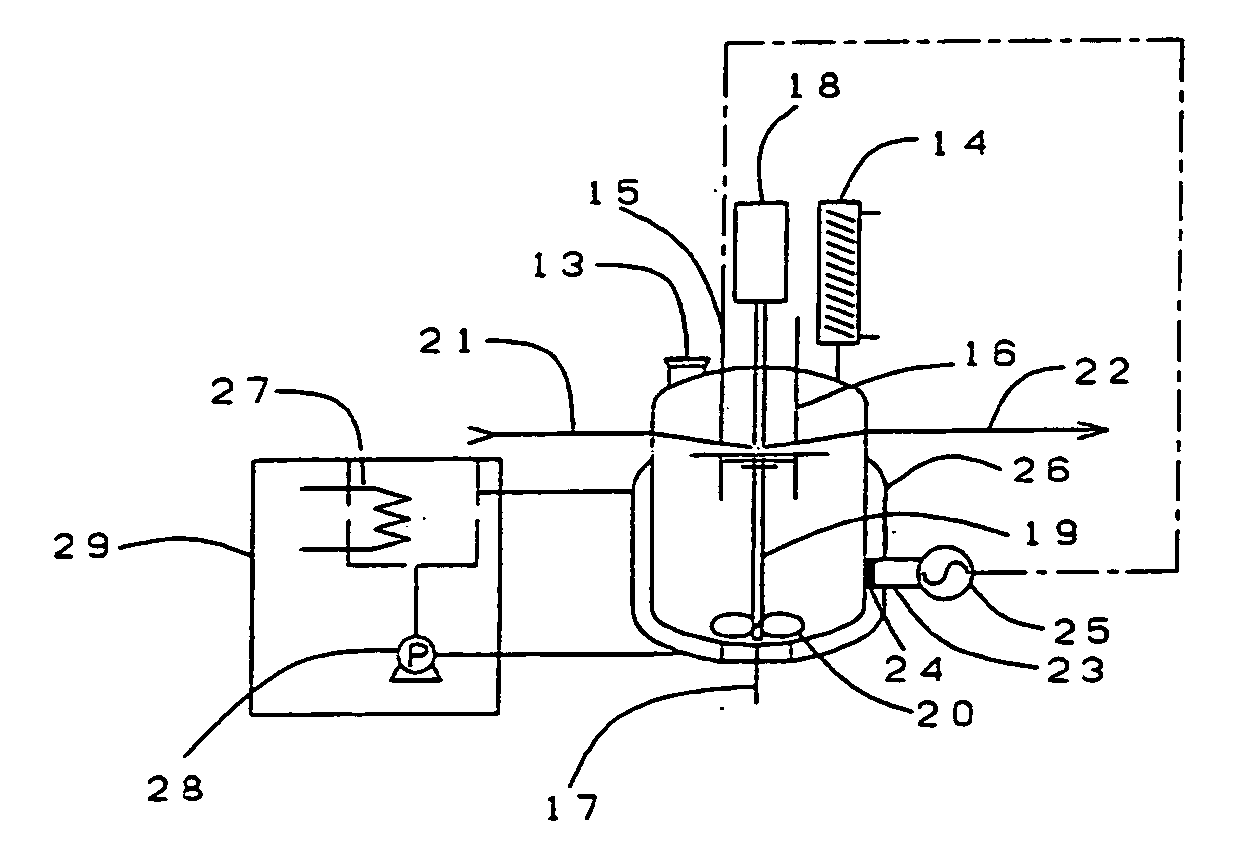Chemical Reaction Apparatus Utilizing Microwave
a chemical reaction and microwave technology, applied in the field of chemical reaction apparatus using microwave, can solve the problems of undeveloped apparatus capable of efficiently performing a reaction and industrial scale, and achieve the effect of efficient reaction
- Summary
- Abstract
- Description
- Claims
- Application Information
AI Technical Summary
Benefits of technology
Problems solved by technology
Method used
Image
Examples
example 1
[0099]FIG. 1 shows a schematic diagram of a microwave chemical reaction apparatus, which is an example of the reaction apparatus of the present invention, provided with a preparatory vessel and capable of performing a continuous reaction consisting of 3 steps.
[0100] The reaction apparatus is consisted of: a preparatory vessel (A) (hereinafter, also expediently referred to as a raw material dissolving vessel) for mixing, heating, dissolving, or melting a raw material for reaction (hereinafter, also expediently referred to as a reaction substrate); a chemical reaction vessel for carrying out the first step reaction (hereinafter, also expediently referred to as a microwave reaction vessel) (B); then a microwave reaction vessel (C) having a role to carry out a large part of the reaction as the second step; and further a microwave reaction vessel (D) to complete the reaction as the third step.
[0101] Hereinafter, a case that 3,3′-diallyl-4,4′-dihydroxyphenylsulfone (abbreviated name: AH...
example 2
[0130] A continuous reaction was carried out using 3 units (B, C, D) of the microwave reaction vessels (effective volume 1.5 liters each) shown in FIG. 5, which were connected each other as shown in FIG. 1.
[0131] Before starting the continuous reaction, the following preparations were carried out.
[0132] A prescribed amount of powdery raw material, 4,4′-diallyloxydiphenylsulfone (AOPS), was charged into the raw material dissolving vessel (A) through the manhole, and AOPS was melted by increasing the temperature in the vessel up to 160 to 180° C., which is not lower than the melting point of AOPS (145° C.) by circulating a heat transfer medium in the jacket. Subsequently, inside of the vessel was replaced with nitrogen to be oxygen-free, while being stirred. At the same time, the nozzle for taking out (5), the metering pump (6), the connecting tube (21) line of the microwave reaction vessel and the microwave reaction vessels (B, C, D) were preheated in advance at a temperature of 16...
example 3
[0137] A batch-wise reaction was carried out using one unit of the microwave reaction vessel (B) shown in FIG. 5 connected to the raw material dissolving vessel (A).
[0138] Before starting the batch-wise reaction, melting of AOPS, preheating, and replacement with nitrogen were carried out similarly as in Example 2.
[0139] After the preparative works were completed, 1.0 kg of the melted raw material, AOPS, was charged into the microwave reaction vessel (B), and inside of the vessel was kept in an oxygen-free state by introducing nitrogen into the vessel. Subsequently, microwaves were irradiated while circulating the heat transfer medium (160° C. to 190° C.) in the jacket. During the batch-wise reaction was carried out, an internal temperature of the reaction vessel was increased at a rate of 8° C. / min in the region from 160° C. to 240° C. by programmed temperature rising, at a rate of 1° C. / min in the region from 240° C. to 260° C. by programmed temperature rising, then kept at 260° ...
PUM
| Property | Measurement | Unit |
|---|---|---|
| frequency | aaaaa | aaaaa |
| temperature | aaaaa | aaaaa |
| temperature | aaaaa | aaaaa |
Abstract
Description
Claims
Application Information
 Login to View More
Login to View More - R&D
- Intellectual Property
- Life Sciences
- Materials
- Tech Scout
- Unparalleled Data Quality
- Higher Quality Content
- 60% Fewer Hallucinations
Browse by: Latest US Patents, China's latest patents, Technical Efficacy Thesaurus, Application Domain, Technology Topic, Popular Technical Reports.
© 2025 PatSnap. All rights reserved.Legal|Privacy policy|Modern Slavery Act Transparency Statement|Sitemap|About US| Contact US: help@patsnap.com



